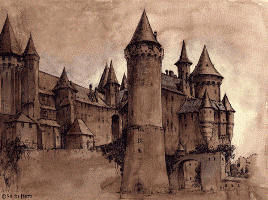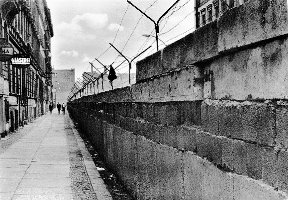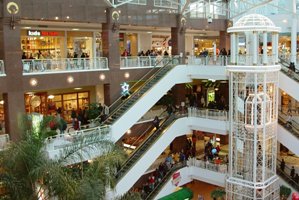How structures concretize a political system’s core social dynamic:

.
Feudalism: Build walls to keep the enemy out.
Examples: the medieval castle, the Great Wall of China.
.
.
.
.

.
.
Socialism: Build walls to keep your people in.
Examples: the Berlin Wall, the Koreas’ DMZ.
.
.
.
.

.
.
.
Capitalism: Create glass wall storefronts to attract other people.
Example: the shopping mall.
.
.
.
.
So here’s a question: Is the above a cheap shot or an essential truth?
It’s not entirely accurate, some of the best socialist “paradises” (like the UK and France) don’t have walls keeping people in…
Dr. Hicks–I think there is SOME truth to this, but it isn’t quite as simple as the pictures make it out. Remember that this capitalist (so-called) nation is building a wall along our southern border.
You misunderstand the history of castles – a castle is a fundamentally offensive structure, it allows the residents of the castle to control the land around them from the relative safety of the castle. This is used both against invading marauders, who must risk asymmetric attacks from the castle residents, and inhabitants surrounding the castle. The basic choice facing a peasant, then, is ‘would I rather be support the residents of the castle, who have at least some interest in keeping me alive in the long term, or live far away from a castle, and be preyed upon by marauders.’
And, of course, if there isn’t a castle nearby, it’s awfully valuable to build one and start asserting dominance and control over the neighboring territory.
There seems to be a fundamental truth to your observations. Perhaps a corollary might be seen in the ability of capitalism to encourage the creative changes in the architecture of markets thus liberating business from medieval market stalls and leading to the magnificent glass-enclosed malls (like the one in your example).
Since this is a visual analogy, it works decently, as does any good analogy — up to a point.
Taken as a straightforward comparison of the three systems chosen it is fair, especially for capitalism vs. socialism. There are certainly exceptions to the socialist case (as cited by one comment), and there are exceptions to the capitalist case (since in capitalism one is *free* to design whatever one likes, and this has included in the 20th century some very closed and defensive-looking structures (New York’s Whitney museum is one example that comes to mind).
As for the feudal case, it was a fact of the inhabited world at the time that fortified structures (for *both* defense and offense — contra Mr. Threadgill) were a rational response to existential threats. So even if a given “nobleman” or early entrepreneur had a highly developed free trade setup in his locale, he would still have to use this architectural form to protect himself and the people around him.
So, I think the visual analogy works best in contrasting capitalism and socialism, and is less successful with the feudal period because the castles and walled cities were responses to facts on the ground, not necessarily or primarily to an oppressive social system.
I agree with most of John Gillis’ comments. However, I’d add that the feudal system was, in essence, a society organized around force, around gangs. The castle’s purpose, offensive and defensive, encapsulates that. The capitalist system is organized around trade.
Consequently, I think your three examples work well.
Love the contrast of the Berlin Wall with the shopping mall (hey, that even rhymes! We could get John Enright to do a poem about your idea!)
Thanks, all, for your comments. One theme that emerges from most of them is this: Given the many uses structures can have in any social system, how does one select which uses are most essential and most illustrative of that system?
One other thought factored into my selection of the images:
I liked how the castle image’s dominant lines were vertical, paralleling feudalism’s emphasis upon hierarchy — how the Berlin Wall image’s lines were horizontal, paralleling socialism’s emphasis upon egalitarian leveling — and how the shopping mall image’s lines were a combination of the vertical (the elevator shaft), the horizontal (the storefront windows), and diagonal (the escalators), paralleling capitalism’s dynamic of people moving in all directions at the same time.
Nice article, and good debate. Also, you used one of my favorite words, “Concretize” – Good on ya!